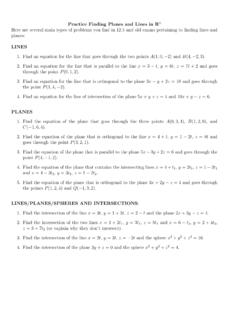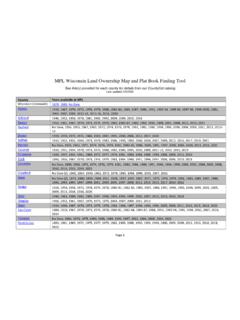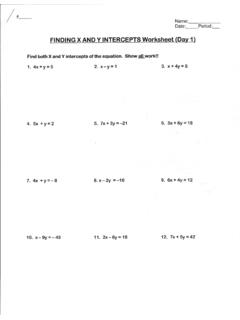Transcription of Map Patterns and Finding the Strike and Dip from a Mapped ...
1 Map Patterns and Finding the Strike and Dip from aMapped Outcrop of a Planar SurfaceTopographic maps represent the complex curves of earth s surface with contour lines thatrepresent the intersection of those curves with (imaginary) horizontal surfaces at regular in-tervals. Planar geologic structures, such as bedding contacts and faults, also intersect theearth s surface along lines. You have seen how folded beds intersecting a flat surface makecurved lines showing the hinges and limbs of the folds, and can be interpreted to determineaspects of the 3D geometry such as the plunge direction of the folds.
2 In this lab you willexplore the intersection of planar features with complex topography which creates mappatterns and how to use these Patterns to interpret the 3rd bedsThe simplest case is one of horizontal bedding intersecting a horizontal flat landscape. Onlythe uppermost bedding plane appears on the map:Figure 1: Flat-lying bedding contacts and flat topographyIn contrast, on a uniform slope, horizontal beds crop out as a series of parallel contacts inmap view. The line of intersection of a geologic surface with topography is called thetraceof the geologic surface. Figure 2 shows the trace of two contacts.
3 Note that the slope governsthe thickness of the units in map view, which is not the same thickness as thetrue thicknessas seen in cross-section view, defined as the thickness measured perpendicular to the beddingcontacts. On the map, one sees theapparent thickness. Shallow slopes increase the ap-parent thickness observed on the map. Steeper slopes show an apparent thickness closer tothe true thickness (with the vertical cross-section on the side of the block showing the truethickness).A valley (with a stream in it shown by dashed line in Figure 3) is the intersection of two1 Figure 2: Flat-lying bedding contacts cropping out on sloped topographysloped surfaces at slightly different orientations.
4 The trace of the bedding contacts intersectsthe two walls of the valley at slightly different angles, forming a V-shape in the trace on themap. For horizontal units, the V-shape that forms is parallel to the contour lines, and there-fore the V points upstream. Also note the difference between true and apparent thicknessof the units. From Figures 2 and 3 you should see that the trace of a horizontal geologicFigure 3: Flat-lying bedding contacts cropping out in a valleyplane must always follow horizontal geologic contact can never cross acontour dipping strata or planar surfacesUnits with parallel strikes and dips (planar units) intersect flat topography as straight, parallellines (Figure 4).
5 The trace of the contacts is equal to the Strike of the bedding surface. Whymust this be true? Mentally picture the change in the map pattern if the top surface of theblock diagram were eroded uniformly by 30%. What would the map look like?2 Figure 4: Uniformly dipping planar units cropping out on flat horizontal landscapeFigure 5: Planar dipping contacts cropping out on a slopeThe same pattern results from dipping beds on a uniform slope, butthe trace of a contactwill not be the same as the Strike of the contact!In other words, the trace in this case is not ahorizontal line in the contact plane.
6 However, it can be used to determine the Strike and dip ofthe plane, because it crosses the plane at an angle and therefore depends on the Strike and of V sA dipping surface that intersects a valley produces a V-shaped trace on a map,unless the dipis vertical(Figure 8). A vertically dipping surface always has a straight map trace, regardlessof the 6: Planar dipping contacts cropping out in a valleyNotice the map Patterns in Figure 8. The direction the V points depends on both thedirection of the dip of the beds, and also on the steepness of the dip relative to the slope ofthe valley floor (see the last example in Figure 8).
7 Usually, the V points toward the directionof dip. The exception is when the dip is in the same direction of the valley slope, but the dipis shallower than the valley. Also notice that the shape of the V changes depending on thedip , notice that the V s in Figure 8 are symmetric ( the apparent bed thickness andFigure 7: Planar dipping contacts cropping out in the valley but not striking exactly perpen-dicular to the valleytrace lengths are the same on both sides of the valley). A symmetric V is produced onlywhen a) the valley itself is symmetric and b) the dip direction of the beds is parallel to theslope direction of the valley floor.
8 This, of course, is not the usual case and most V s in mapview are thus asymmetric (Figure 7).4 Figure 8: The Rule of V s for different dipping surfaces crossing a valley5 Determining Strike and Dip Directions from Map PatternsFrom the discussion above, it should be apparent that a rough approximation of thedirectionof dipcan be made by noting whether a V points up or down the valley. What aboutstrike? By definition, Strike is always perpendicular to dip and is the line of intersection ofa horizontal plane with the geologic plane. If a dipping surface crosses valleys and ridgeswe can constructstrike lines(also calledstructure contours) to precisely determine Strike line is a line connecting two or more points on a geologic surface that are at theFigure 9: Construction of Strike lines for planar beds crossing a valley.
9 Note that the 300 contour is west of the 400 contour, indicating that the bedding contacts dip downwardstoward the elevation (Figure 9). By drawing a line between two points on a surface that are atthe same elevation, you can define the intersection of a horizontal plane with the surface in6question, and thus the Strike of that geologic surface. Strike lines are labelled by example, the 400 Strike line in Figure 9 connects the two exposed points on the contactbetween the white and grey units (the base of the gray unit) where that contact surfacecrosses the 400 topographic contour.
10 Because a planar surface can have only one Strike ,all the Strike lines on a surface must be parallel if the surface is strikelines on a surface indicate that the surface is not planar, such as folded beds and erosionalunconformities. This condition can be used to differentiate between Vs formed by planarbeds crossing V-shaped topography, versus folded Strike lines in this way is the easiest way to determine the attitude ofcontacts and faults, and provides a quick check on whether surfaces are planar. This is alsoa powerful predictor of where a contact should intersect topography when mapping, if thestrike and dip of the contact are known.








